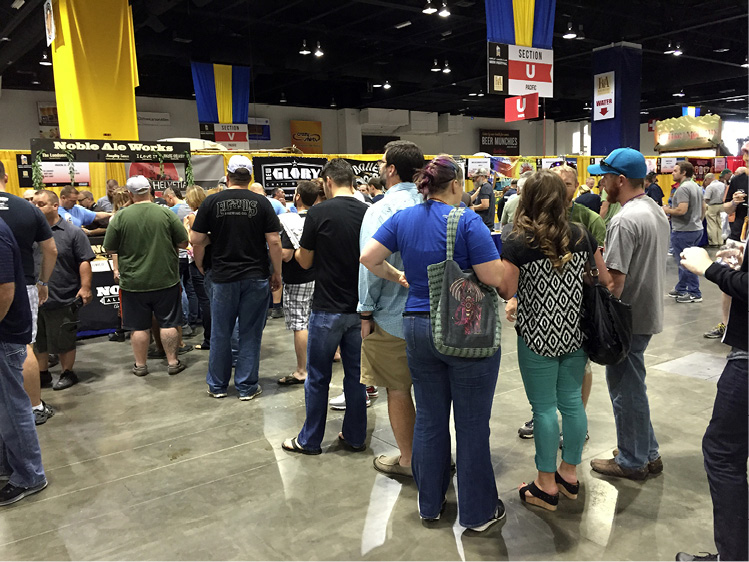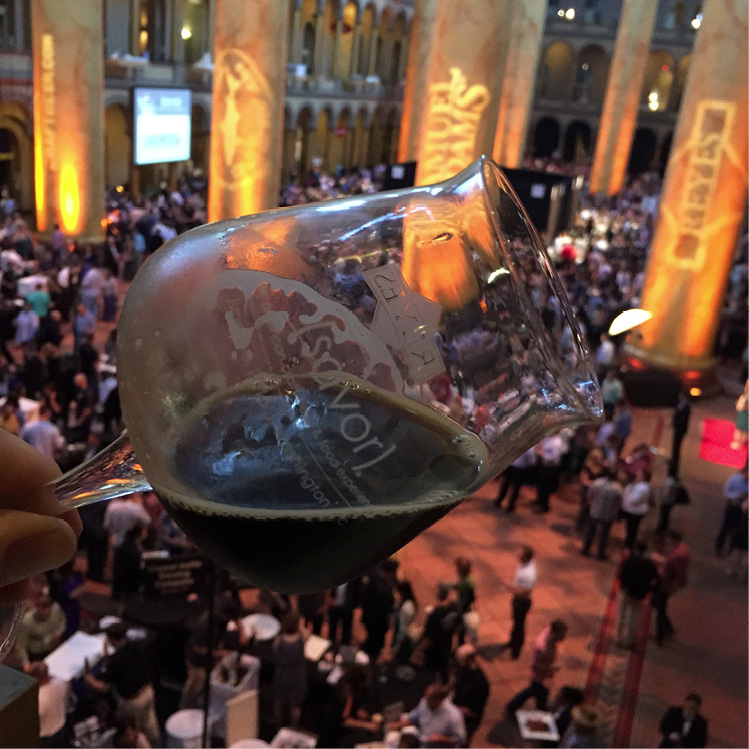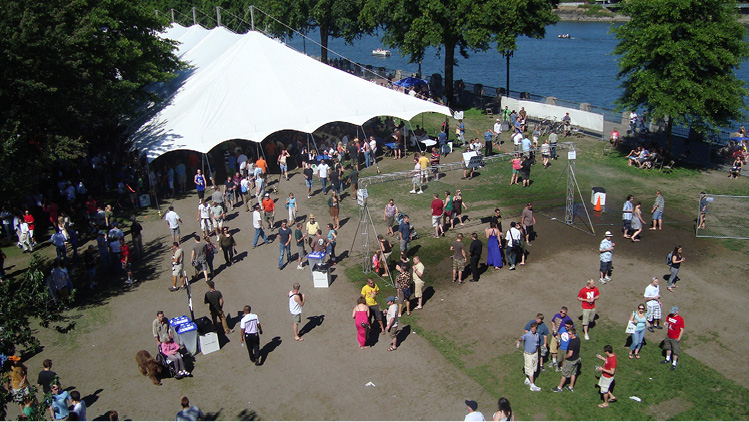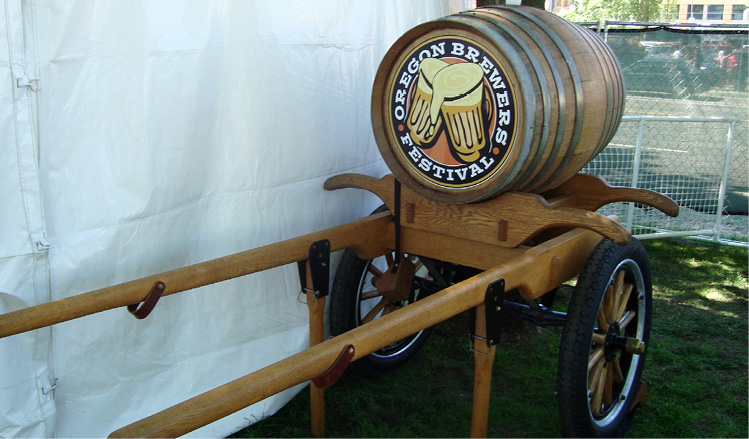Navigating the Great American Beer Festival and Beyond
Sturgeon’s law or Sturgeon’s revelation, named for American science-fiction author Theodore Sturgeon, states that 90 percent of everything is crap. If Sturgeon had ever gone to a beer festival, he might have upped that percentage to at least 95 or 96.
Along with the explosion in the number of US craft brewers—around 5,000—there’s been a corresponding proliferation of beer festivals. And, as expected, the vast majority aren’t very good. Unfortunately, when an industry is hot, it tends to attract more opportunistic carpetbaggers than it does emotionally, as well as financially, invested organizers who put their hearts and souls into staging a world-class event.
The Anatomy of a Festival
No two beer festivals are exactly alike, but there are common elements one would expect to find at just about all of them:
Pouring tables: Individual tables or pouring stations representing a particular brewery, importer, or distributor, form a circuit across the floor of the host space, be it a convention or civic center, sports arena, hotel, abandoned armory, or outdoor park or field. Each station features a portable draught system, bottles, or a combination of the two.
Tasting glasses: Registered attendees receive a commemorative glass—most frequently with a 6-ounce capacity, but sometimes larger. More often than not, for various safety and liability issues, those “glasses” are actually plastic. However, it’s not uncommon to find actual glass.
Long lines at “white whale” stations: The beer drinking community has its fair share of white whales, those hard-to-find one-offs or extremely limited releases, that many brewers roll out on special occasions. When such brands make appearances in a festival setting, beer geek Ahabs gravitate en masse to those particular brewers’ tables, waiting sometimes an hour or more of the festival (and most festival’s tasting session’s only last three or four hours) for a one-ounce pour of their Moby Dick. And the brew usually runs out within that hour, rendering the quest fruitless. It’s actually a very welcome development for those indifferent about chasing large sea mammals. While their peers are reenacting their least favorite Disney World memories, it’s minimizing the wait at other tables.
Festival pricing procedures can vary. At some, attendees pay one price in advance, get a wristband and a tasting glass, and taste as many different beers as they can as many times as they want. Others sell drink tickets or tokens, limiting the number of tastes festival-goers can get. Some let drinkers re-up when they’ve run out; others will include, say, ten tickets or tokens with each admission and not allow any additional purchases. Once gone, the attendee may either leave or switch to water. The rationale is that festival organizers don’t want the event they’ve worked many long hours to stage to devolve into one colossal drunk fest. Sadly, though, that’s usually very difficult to prevent—which brings us to the No. 1 component of a truly awful beer festival.
Any time an event invites members of the public to drink as much they can in a four-hour period, it’s going to attract an unsavory element to the premises: the binge drinker who’s determined to get at least double his or her money’s worth. To them, a beer festival is like a happy hour promotion on steroids. It’s impossible to completely eliminate such behavior from a tasting session; but it’s easy enough to ensure that inebriated bingers remain in the minority.
But, the thing is, the carpetbaggers don’t seem to care. They’re just trying to get bodies in the door and make a profit and, tragically, that means appealing to the lowest-common denominator.
The reputable festivals are reputable for a reason: because they earned it. For some of them it’s taken years, even decades, of trial-and-error, ironing out the kinks and figuring out what works and jettisoning what doesn’t.
The Great American Beer Festival
The Great American Beer Festival (GABF) got to be great by doing just that. The first edition was in 1982, when it occupied just 5,000 square feet. It has since grown about sixtyfold to take over most of Denver’s Colorado Convention Center each fall, attracting some 60,000 attendees over its three days and selling out within about three minutes after tickets go on sale.
The same organization—or at least an evolved iteration of the original organization—has been running it for the thirty-odd years it’s been operating.
Originally there were two trade associations representing the nation’s craft brewers, Brewers’ Association of America and the Association of Brewers. The two merged in 2005 to form the Brewers Association, which continues to manage the colossal event to this day.
The most striking aspect of the GABF is the wait time on the lines—or lack thereof. During the three-day event, Denver should change its nickname to the Mile-Long City because that’s the length of the queue—no hyperbole—thirty minutes before a tasting session. Anyone arriving at 5:00 p.m. for the 5:30 session might get depressed, thinking that they’ll be lucky to get in the door twenty minutes before last call. But they’re pleasantly surprised to discover that the timespan from the moment the main door opens until the first beer is poured into their glasses is all of about fifteen minutes. Well-oiled machine is an understatement.
Despite its sprawling layout across the convention hall’s floor, it’s remarkably easy to navigate, even for a newbie. Each row of tasting tables is categorized by region of the country—West, Midwest, Southeast, etc.—and the attending breweries are arranged alphabetically within those sections.
Most of those doing the pouring are volunteers, which generally is a bad thing at lesser festivals. Try asking a volunteer about style or hop character at one of those events and you’re likely to get a shrug or a deer-in-the-headlights look. That’s not to say GABF volunteers are experts, but a majority of them are knowledgeable craft beer enthusiasts—most of them are from Colorado, after all—and are eager to talk about what they’re pouring with folks who share their passion.
GABF is by no means the perfect festival. There are plenty of cringeworthy elements. There’s a fair level of drunkenness and people behaving stupidly. There are four tasting sessions—one each on Thursday and Friday and two on Saturday—and knowing which one to attend is half the battle in avoiding such activity. Thursday night is usually a good bet; the crowd tends to be mellower. Saturday afternoon is optimal, but attendees must be members of either the Brewers Association or the American Homebrewers Association (AHA) to be admitted. (Annual membership is around $45, and it’s well worth it, not just for access to the members-only Saturday session but for a host of other benefits and discounts across the country throughout the year.)
The other main attraction on Saturday afternoon is the presence of a larger number of actual brewers. The festival’s awards ceremony immediately precedes—and often runs over and overlaps with—the session, and more brewery personnel—top brass, marketing and sales reps—will be hanging out at their booths (the bigger ones get these) or tables. So for those who really want to drill down into the stylistic nuances of the liquid being poured, Saturday’s the day to try to make that happen.
Another plus? Since Saturday afternoon attracts, by and large, a more seasoned craft enthusiast, attendees are entrusted with tasting glasses made of actual glass; plastic is the only option during the other three. It’s like getting to sit at the grown-up table at Thanksgiving dinner.
The one component that Saturday lacks, though, is the Farm to Table Pavilion, which has been a popular addition to GABF since 2009. It’s an added charge for admission, but it’s money well spent. It’s an oasis amidst the madness of the tasting hall in its own separate room. Participating brewers pair select creations with culinary delights fashioned under the guidance of chef Adam Dulye. There’s plenty of food to go around—everything from artisanal sausage to oysters—and no one leaves hungry. One would spend far more on dinner to get the same caliber of food that’s sampled at Farm to Table.
It’s a sort of mini-version of the Brewers Association’s other signature pouring event, Savor.

The famous lines at GABF.
Savor
If GABF is craft beer’s Super Bowl, Savor is its Oscar night. People dress a bit better (sport jackets and dresses are the norm), pay a bit more, and enjoy more of a cocktail party vibe than GABF’s Mardi Gras-like aesthetic. But included in the $135 admission price (as of 2016) is food—great food, at that, and lots of it. Dulye also leads the gastronomic efforts for Savor, cranking out choice bites to complement the wares of some seventy American breweries.
Its usual home is Washington, D.C.’s stately National Building Museum, though it made a brief detour in 2013 to New York’s Metropolitan Pavilion. However, there really is no substitute for the museum in the US capital, with its towering marble columns and multistory atrium. It began as a single Saturday night event at a different venue—the Andrew Mellon Auditorium—but it has since settled on the Building Museum and has expanded to include a Friday evening session.
The District of Columbia works so well for the event because it serves a dual purpose. It’s the one time of year that the nation’s craft brewers can storm Capitol Hill en masse and tell their collective story to federal lawmakers. A goodly proportion of each night’s 2,000 or so tickets are set aside for members of Congress and their staff (mostly the latter).
It’s also quite a hot ticket for the brewers themselves. Since space is limited, any of the nearly 5,000 American craft operations must enter a lottery for a slot, unless they’re among the “sponsoring” breweries—usually the likes of Dogfish Head, Brooklyn Brewery, Sierra Nevada, New Belgium, and other big craft players—that fork over significant cash for a guaranteed presence and a prime spot in the tasting hall. Those who win the lottery are required to send someone senior from the brewery to pour and expound on their offerings. And that’s the element that makes it such a top-notch event. It’s a rare chance for the public to interact with a veritable who’s who of craft brewing entrepreneurs.
The absence of that A-list factor frequently is the major failing of most lesser festivals. Too often the tasting stations are manned by individuals who lack any knowledge of or emotional investment in the brands that they’re repping at these events. Better brewers have local reps partnering with a region’s distributors to not only sell the brands to retail customers, but educate those customers, who, in turn, can make more informed sales pitches to consumers. All the rest are beer producers who want to be everything to everyone; they want to boast about how many US states they’re in without having any personnel in those states to make a credible impact. When there’s a beer festival in an outlying area not core to their consumer base, those brewers are hard-pressed to get someone to staff their pouring stations. And most of the local/regional events possess neither the savvy nor the reputation of a GABF to attract or train capable volunteers to serve as well-informed proxies for the beers being served. In such instances, it’s not entirely out of the ordinary for the organizers to recruit convention center or hotel staff to perform the serving duties. And the ones assigned to that duty tend not to be very enthusiastic about it. Sometimes they’re downright rude, which, ultimately, is a horrible reflection on the brands. Not naming any names here to protect the not-so-innocent.
The Brewers Association, however, is far from being the only organization/company capable of staging a stellar beer festival.

Savor, the premier craft beer and food event, at the National Building Museum in Washington, D.C..
World Beer Festival
The most notable among those not hosted by the Brewers Association is the World Beer Festival, which actually isn’t a single event but a series of festivals throughout the year in multiple locations—many of them outdoors. It’s organized by the folks who run All About Beer magazine, one of the oldest and most respected publications specifically for beer enthusiasts.
Columbia, South Carolina, is the host city for its January festival; Raleigh, North Carolina, is the backdrop for April; Cleveland, Ohio in June; and Raleigh’s neighbor, Durham (the magazine’s home city), in October. Most recently the team launched a Charlotte, North Carolina event, as well as one at northern New Jersey’s Meadowlands Racetrack.
The Durham festival is the brand’s oldest. Daniel Bradford, who bought All About Beer in 1991, launched it in 1996. Bradford was the head of the Brewers Association of America until it merged with the Association of Brewers to form the Brewers Association in 2005. Bradford knows a thing or two about running a beer festival; he was one of the founders of the GABF. Bradford ultimately sold All About Beer and its festivals to Christopher Rice in 2014.
The North Carolina events each draw between 7,000 and 10,000 visitors who are eager to sample products from some 100 breweries.
“Our events are started in places that did not have a core beer community,” Rice notes. “There was no craft beer presence in Columbia [when it launched there] in 2008. There were no tap rooms, no retailers, and there are a number of people in the market [who] credit All About Beer for showcasing the world of craft beer, creating demand and a real brewing community.”
BeerAdvocate Presents . . .
Media companies seem to have a knack for organizing solid beer fests. BeerAdvocate, which had built an enormous web community years before it decided to launch a monthly print publication of the same name (in the opposite order of how things normally work), stages a couple of annual gatherings in Boston (BeerAdvocate’s original base), each focusing on a particular theme.
Boston is not at the top of most people’s list of places to be in February, but BeerAdvocate keeps everyone plenty warm with the bold, boozy, high-ABV brews that are the centerpiece of its Extreme Beer Fest.
The publication/website also stages the American Craft Beer Festival, which BeerAdvocate hosts in conjunction with Boston’s Harpoon Brewery. The event showcases between 600 and 700 beers from more than 140 American breweries. It’s usually held in late spring, usually the end of May, and typically draws about 15,000 eager beer enthusiasts.
Oregon Brewers Festival
The most enduring summer beer festival has been the Oregon Brewers Festival, which is well into its third decade. When it comes to venues, few can claim to offer the precise mix of urban hipness and picturesque natural beauty that downtown Portland serves up in spades.
Some 85,000 beer lovers converge on the city’s Waterfront Park in late July to sample some nintey brews as they gaze across the mighty Willamette River and its iconic bridges (thanks partly to Portlandia). When the sun’s out—and it usually is that time of year—snowcapped, majestic Mount Hood looms just off in the distance.
It’s one of the rare festival’s that’s not a ticketed event. Attendees can wander in for free if they just want to hang out. If they want to drink (and there’s a 99.9 percent chance that they do), first they must purchase the 14-ounce souvenir plastic tasting mug. If they want anything poured in said mug, they’ve got to buy $1 wooden tokens—as many as they like. One token for a taste, four for a full pour (rare offerings fetch two tokens a taste).

The Oregon Brewers Festival.

The Oregon Brewers Festival.

Belgium Comes to Cooperstown
Twenty-eight hundred miles away, upstate New York’s Adirondack Mountains provide the backdrop for one of the other world-class outdoor summer festivals, Belgium Comes to Cooperstown (BCTC). Hosted on the sprawling 140-acre grounds of Cooperstown’s well-regarded, Belgian-inspired Brewery Ommegang, BCTC has become the Woodstock of craft beer, complete with sprawling tent city and live acts. Overnight camping is a key part of the experience; once the afternoon pouring session ends, bands play well into the night as revelers grill burgers and dogs on portable hibachis and propane-fueled stoves. The event has evolved beyond its Belgian roots; sure, Ommegang models itself after a Flemish farmhouse brewery and is owned by Belgium’s Duvel Moortgat, but the growing roster of guest companies that pour at the festival offers selections that draw on a range of international and domestic influences.
Scoring tickets has gotten progressively more difficult; like GABF, BCTC passes disappear within minutes of the start of the public sale.
Other Fests of Note . . .
TAP New York
Upstate New York is also home to an annual festival that has gained quite a cult following in the region: TAP New York. The fest, held in the Hunter Mountain ski region at the start of the off-season in late April, launched in 1997 and bills itself as the longest-running event of its kind in the state. It also claims to be the largest single-state craft beer festival in the United States. Recent editions of TAP New York have welcomed more than 120 Empire State breweries, showcasing more than three hundred individual beers. TAP prides itself on being about not just imbibing, but education.
Denver Rare Beer Tasting
We’re going to bring things back to where we started: the Mile High City. The Denver Rare Beer Tasting is a separate event that runs each year for an afternoon during the Great American Beer Festival (not during the main tasting sessions, mind you). The event, usually staged a few blocks away from the Colorado Convention Center at the McNichols Civic Center features the wares of about fifty brewers—mostly their harder to get stuff, hence the name—and it’s all for a good cause. It’s organized by Pints for Prostates, which raises prostate cancer awareness. Noted beer writer and prostate cancer survivor Rick Lyke founded the organization in 2008. It’s a separate ticket price from GABF and it usually sells out nearly instantaneously. But not only is it the opportunity to sample some off-the-beaten path brews, it also offers the chance to rub elbows with the brewerati (and you’re more likely to run into the likes of Sam Adams mastermind Jim Koch and Dogfish Head’s Sam Calagione than in the gargantuan GABF tasting hall).
Big Beers Festival
Since we’re already in Colorado, there’s one more worth noting. The name says it all. Don’t expect to find too many session ales and lagers at this event, which is staged each January—during peak ski season, of course—in Vail. Three hundred-plus bold brews pour throughout the festival, which also boasts one of the most extensive educational components found at a tasting festival. Most of the sessions are led by top brewers sharing their insights on their own beer-making experiences.
Holiday Ale Festival
There’s no shortage of outdoor beer festivals in Portland, Oregon, regardless of the season. When things start to get considerably colder in December, it’s time for the annual Holiday Ale Festival, a tradition dating back to the mid-’90s. It’s staged at the city’s Pioneer Courthouse Square under the shadow of an enormous Christmas tree. The more than 14,000 attendees that typically show up to try the big, boozy winter offerings from a host of mostly Western breweries needn’t worry about freezing to death. The entire event takes place under a giant clear-roofed tent, complete with heaters. Holiday music is piped in to enhance the festive vibe.
Michigan Winter Beer Fest
And speaking of cold . . . it’s February, and it’s Michigan, which is not a place known exactly for mild winters. But, so what? Michiganders have more than made their peace with that reality. In fact, they embrace it and very bravely host Winter Beer Fest outdoors. It’s definitely not a deterrent because the festival has upped its attendance tenfold since it first launched in 2006. Now, more than 10,000 people flock to a ballpark to sample a thousand beers from more than one hundred different breweries. And when there’s snow on the ground, it only enhances the experience.
Festivals Outside the US
If you leave the country and you play your cards right, your trip just might coincide with some of the more renowned international beer festivals.
Great British Beer Festival
Denver has the GABF. London has the GBBF. This one’s the brainchild of the Campaign for Real Ale (CAMRA)—you remember them; they’re the saviors of traditional British ales and the pubs that serve them. The Great British Beer Festival predates pretty much every beer festival in the United States, including the aforementioned Great American Beer Festival. GBBF kicked off in 1977, a full five years before the inaugural GABF. The event has bounced between the city’s Earl’s Court and Olympia exhibition centers. The August festival attracts 55,000 thirsty attendees, who sip and savor nearly six-hundred brews on tap, as well as hundreds of bottles (including cider). GBBF is more than a festival, it’s kind of one giant pub, complete with traditional pub games. Among those is Skittles, a sort of wooden, tabletop bowling game. Then there’s Shut the Box, a game that involves twelve cards and a set of dice. There’s even a bobbing for apples station. (Even Prince Harry has been known to show up at the GBBF and join in the fun.) The Brits know how to party!
A much smaller-scale child of the GBBF is the Pig’s Ear Festival, which takes place at the beginning of December in what was once a rather large church in the Borough of Hackney. Visitors get to sample nearly 250 real ales, as well as ciders, perries (pear cider), and bottled beers (and damned good sausages, bacon rolls, and barbeque to boot). And many of the same pub games make an appearance on the Pig’s Ear tasting floor, as well.
Zythos Bierfestival
Naturally, there must be an iconic beer festival in Belgium. The Zythos Bierfestival is the best known of the Benelux fests, and many would be surprised out how relatively new it is. The spring event started in 2004 in the town of St-Niklaas, but has since moved to Leuven (coincidentally the home base of what was Interbrew, the company that became InBev and that is now AB InBev). The two-day festival showcases around five hundred Belgian beers. It’s impossible to hit every brewery in Belgium on a single trip, so the closest most will get to doing so would be sampling the cross-section of fine brews at Zythos.
Beervana
The development of the New Zealand craft beer scene has paralleled that of Australia, and the best representation of that phenomenon happens every August in Wellington. (Sometimes it overlaps with the GBBF; if it’s an either/or scenario, you always could choose based on the weather. If you hate winter, you’re better off hitting the British event, though Wellington winters are more like early spring). There are plenty of Kiwi beers to try at Beervana, along with a generous helping of brews from other craft cultures around the world.
Mondial de la Biére
Let’s bring things back to North America for what has become one of the world’s most epic tasting events. The five-day Montreal festival has been a fixture of the Quebecois beer scene since 1994 and has grown to attract more than 100,000 beer lovers to the city’s Palais de Congres. Mondial de la Biére (World of Beer) also features a comprehensive educational component, with professional seminars throughout the fest. And, as it turns out, it got so huge that Montreal alone couldn’t contain it. The organizers have gone on to launch festivals in Mulhouse, France, and Rio de Janeiro, Brazil. It’s truly living up to its name.